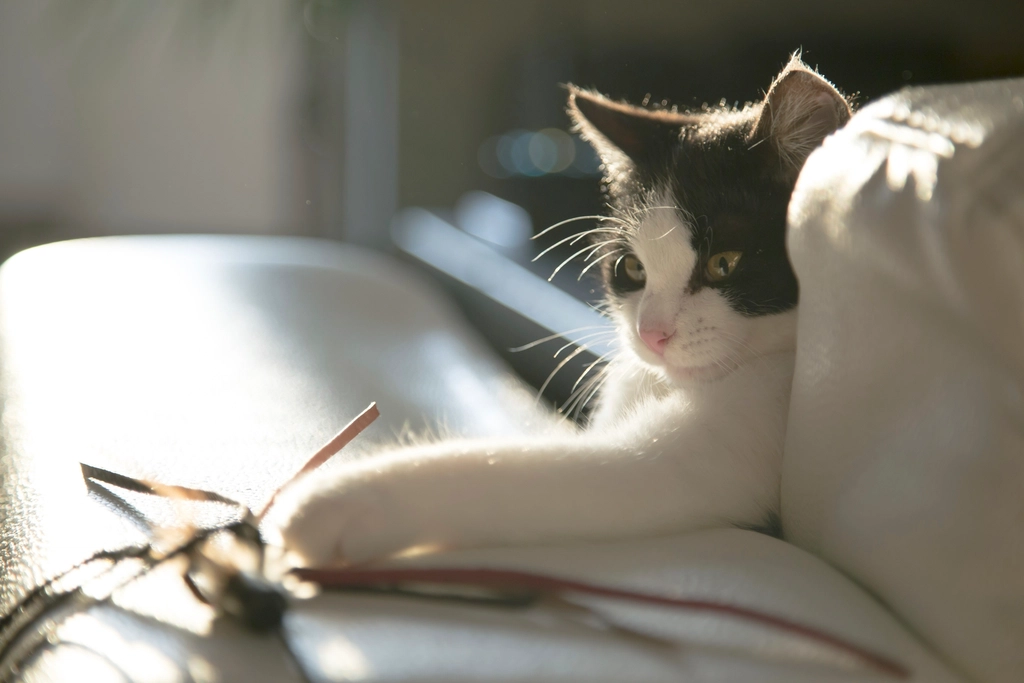Have you ever watched a cat stretch out in a sunbeam, completely content and utterly at ease? There’s something magical about the way cats show their love—on their own terms, never forced. For cat enthusiasts, the struggle is real: we adore our furry companions and want to shower them with affection, but sometimes our enthusiasm can feel overwhelming to our feline friends. How do you strike the perfect balance between showing up for your cat and allowing them space to just be? Welcome to the gentle art of being present without pushing affection—a journey that requires patience, mindfulness, and a touch of feline wisdom.
Understanding Your Cat’s Body Language

Learning to interpret your cat’s body language is like unlocking a secret code. A flicking tail, flattened ears, or slow blinks each tell their own story. When your cat arches its back and purrs, it’s usually a sign of trust. But if the tail is puffed up or the ears are pinned back, it’s time to give some space. Paying close attention to these subtle signs helps you know when your cat is open to attention and when they’d rather be left alone. It’s a bit like reading the mood of a close friend—you don’t need words to know when to step back. By respecting these cues, you build a foundation of trust that grows stronger with time. This understanding is the first step in being present without overwhelming your cat.
Respecting Their Need for Independence

Cats are famously independent. They thrive on having control over their environment and interactions. If you’ve ever tried to cuddle a cat who isn’t in the mood, you already know how it ends—they slip away with a flick of the tail. Giving your cat the freedom to come and go as they please shows respect for their boundaries. Letting them initiate contact, rather than always reaching out first, builds trust and reassures your cat that their autonomy is safe with you. Imagine if someone tried to hug you every time you walked into a room—you’d want some space, too! Independence is not distance; it’s a sign of a healthy relationship.
Creating a Safe and Comfortable Space

A cat that feels safe is more likely to approach you for affection. Make sure your home has cozy spots where your cat can retreat and relax without being disturbed. This could be a sunny windowsill, a soft bed, or a high perch. When your cat feels secure, they’ll often seek you out for company. You can even make their space extra inviting with blankets or a favorite toy. Remember, you’re not just their owner—you’re their safe haven. Providing a comfortable environment shows your cat that you respect their needs and want them to feel at home.
The Power of Quiet Presence

Sometimes, the most powerful way to connect with your cat is simply to be there. Sit quietly in the same room, reading or working, and let your cat decide when to approach. This gentle presence lets your cat know you’re available without any pressure. Cats are naturally curious, and often, they’ll come over just to see what you’re up to. This approach is like being around a shy friend—letting them warm up to you on their own time leads to more meaningful connections. Your calm energy can be reassuring and inviting, even if no words (or meows) are exchanged.
Letting Your Cat Set the Pace

Every cat has their own rhythm. Some are social butterflies, while others prefer solitude. Letting your cat choose when and how they interact with you is key to building trust. Watch for signs that your cat wants attention—a gentle head bump, a soft meow, or curling up next to you. Other times, they may simply want to nap or explore on their own. Respecting their pace shows that you value them as individuals. It’s a bit like dancing—you have to let your partner lead sometimes for the dance to feel harmonious. Trust the process and celebrate the little moments your cat offers.
Practicing Mindful Interactions

When you do interact with your cat, focus on being fully present. Put away your phone, turn off the TV, and give your cat your undivided attention. Notice the feel of their fur, the sound of their purr, and the way they move. Mindful interactions deepen your bond and make your cat feel truly seen and appreciated. It’s easy to get distracted, but your cat can sense when you’re not fully engaged. By being mindful, you show your cat that their company is more important than anything else at that moment.
Understanding the Value of Routine

Cats love predictability. Establishing a routine—like feeding, playtime, or quiet time together—can help your cat feel safe and secure. When you stick to a routine, your cat knows what to expect and feels more at ease. This sense of stability makes it easier for your cat to trust you and seek out your company. For example, a regular evening cuddle before bed can become a cherished ritual. By honoring their need for routine, you create a foundation of reliability and comfort.
Using Gentle Touches and Soft Voices

When your cat does seek affection, use gentle touches and a soft, soothing voice. Avoid sudden movements or loud noises that might startle them. Stroke their fur lightly, focusing on areas they enjoy like under the chin or behind the ears. Each cat has their favorite spots, so pay attention to their reactions. Soft voices and gentle touches communicate love without overwhelming your cat. It’s like whispering a secret—they feel special, safe, and respected. Always let your cat guide you on what they like best.
Recognizing When to Step Back

Sometimes, the most loving thing you can do is give your cat space. If your cat walks away, hides, or shows signs of stress, respect their need for alone time. Pushing for affection when your cat isn’t in the mood can damage your bond and make them wary. Think of it as giving someone breathing room when they’re feeling overwhelmed. Cats are sensitive to energy and will return when they’re ready. By stepping back, you show your cat that you care about their comfort above your own desires for closeness.
Encouraging Play Without Pressure

Play is a wonderful way to bond with your cat, but it should always be on their terms. Offer toys and let your cat choose whether to join in. Some cats love chasing feathers, while others prefer batting at balls or solving puzzle toys. If your cat isn’t interested, don’t force it—just leave the toys out and give them time. Playtime can be a bridge between independence and affection, creating joyful moments without any pressure. Celebrate your cat’s unique play style and let them lead the way.
Rewarding Positive Interactions

When your cat seeks you out or responds positively to gentle affection, reward them with treats, praise, or a favorite activity. This reinforces their trust and encourages them to repeat the behavior. Positive reinforcement is more effective than trying to coax or force affection. Over time, your cat will associate your presence with good things, making them more likely to approach you in the future. It’s like building a friendship—small gestures of kindness add up to a deep, lasting bond.
Appreciating the Little Moments

Not every interaction needs to be a grand display of affection. Sometimes, the most meaningful moments are the quiet ones—a soft purr, a brush against your leg, or a shared glance. Celebrate these small signs of connection. They might not seem like much, but to your cat, they’re significant. By appreciating the little moments, you show gratitude for your cat’s unique way of expressing love.
Learning from Your Cat’s Example

Cats are experts at being present. Watch how your cat moves through the world—mindful, patient, and always aware of their surroundings. They don’t rush affection or force interactions; they simply exist in the moment. By taking a page from your cat’s book, you can cultivate a more mindful approach to your own relationships, both with your pet and with others. Let your cat inspire you to slow down and savor the present.
Balancing Affection with Respect

It’s natural to want to show your cat how much you love them, but real affection is a two-way street. Strike a balance between showing care and respecting your cat’s preferences. If they want to cuddle, embrace the moment. If they need space, honor that too. This balance is the key to a healthy, happy relationship. Your cat will feel more secure, and you’ll enjoy a deeper sense of connection.
Building Trust Over Time

Trust doesn’t happen overnight. It’s built through consistent, respectful interactions and a willingness to let your cat set the pace. Be patient and persistent, even if progress feels slow. Each positive interaction adds a brick to the foundation of trust. Over time, your cat will come to see you as a safe, reliable presence in their life. The reward is a bond that’s both strong and enduring.
Handling Setbacks with Patience

Even the best relationships have their ups and downs. If your cat suddenly becomes distant or less affectionate, don’t take it personally. Changes in behavior can be caused by stress, illness, or simply a shift in mood. Give your cat time and space, and continue to offer gentle support. Patience is key—forcing affection will only set you back. Remember, your cat’s trust is a gift, not a guarantee.
Communicating Without Words

Cats and humans speak different languages, but love transcends words. Use your body language, energy, and actions to communicate care. Slow blinks, gentle touches, and calm presence all speak volumes to your cat. Pay attention to how your cat responds and adjust your approach accordingly. Over time, you’ll develop a silent language all your own, built on mutual understanding and respect.
Not Comparing Your Cat to Others

Every cat is an individual, with their own personality and preferences. Resist the urge to compare your cat to others, whether it’s a friend’s cuddly lap cat or a social media sensation. Celebrate your cat for who they are, quirks and all. Embracing their uniqueness fosters a deeper connection and helps you appreciate the special bond you share. Your cat’s way of showing affection is perfect, simply because it’s theirs.
Staying Consistent and Reliable

Consistency is comforting for cats. Show up for your cat every day, in big ways and small. Feed them at the same time, greet them when you come home, and keep their environment stable. This reliability creates a sense of security that allows your cat to relax and be themselves. When your cat knows they can count on you, they’re more likely to seek you out for companionship.
Celebrating Your Cat’s Boundaries

Boundaries aren’t barriers—they’re invitations to deeper trust. When you honor your cat’s need for space, you show them that their feelings matter. This respect lays the groundwork for a healthy, loving relationship. Celebrate your cat’s boundaries as a sign of trust, not rejection. Over time, your patience and understanding will be rewarded with moments of closeness that are all the more meaningful because they weren’t forced.

Growing up traveling and experiencing new cultures and wonders, I have had a passion for nature, adventuring, photography, and videography. I am currently working towards a BSc in Biodiversity and Ecology at Stellenbosch University, and I hope to specialise in Marine Sciences one day.
Please send any feedback to Feedback@animalsaroundtheglobe.com






